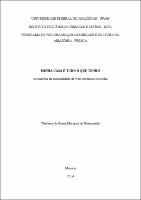| ???jsp.display-item.social.title??? |


|
Please use this identifier to cite or link to this item:
https://tede.ufam.edu.br/handle/tede/4215| ???metadata.dc.type???: | Tese |
| Title: | Minha casa é tudo o que tenho: os sentidos da sociabilidade da vida cotidiana ribeirinha |
| ???metadata.dc.creator???: | Nascimento, Thatyana de Souza Marques do  |
| ???metadata.dc.contributor.advisor1???: | Witkoski, Antonio Carlos |
| ???metadata.dc.description.resumo???: | Esta pesquisa tem como objetivo compreender os elementos e condições para que um espaço arquitetônico adquira o status de lar. Do ponto de vista arquitetônico, ao conceber uma casa deve-se pensar no mobiliário e nos objetos que irão ambientá-la, além dos materiais a serem usados que darão suporte à organização do espaço. Esta perspectiva baseia-se no conceito de arranjo e ambiência. A estrutura do arranjo revela o aspecto organizacional, pois está relacionado com a disposição e combinação dos objetos de forma a obter um conjunto funcional. Já a estrutura da ambiência compreende o meio pelo qual cores, materiais, forma e textura se combinam no ambiente construído com a finalidade de possibilitar o arranjo pretendido. O projeto arquitetônico final é visto como sendo o somatório desta investigação – a estrutura do arranjo em conjunto com a estrutura de ambiência, tendo sempre em mente os valores sociais de quem irá habitar a casa. E a aquisição de certos bens e a forma como são utilizados irão nortear diferentes linhas de projetos arquitetônicos ou reforçar outras. Os sujeitos da pesquisa – moradores da localidade Boa Esperança, na Reserva de Desenvolvimento Sustentável Amanã, estado do Amazonas – e a permanência em suas casas impulsionaram ampliar a perspectiva inicial. Foi possível constatar que o sentido de estar em casa está relacionado com mais intensidade às relações sociais estabelecidas em torno dela. Na medida em que a influência do componente humano prevaleceu como sendo o centro de valor e a fonte de significado para que o espaço arquitetônico seja considerado uma casa de moradia, este passou a incorporar mais as marcas das relações sociais entre residentes e não residentes do que as marcas de arranjo e ambiência. Portanto, não são somente os objetos que remetem ao sentimento de estar em casa, mas algo que precede. “Minha casa é aqui dentro” resume o sentimento de pertencimento à região, elemento que possibilita a este espaço arquitetônico adquira o status de lar. O “aqui dentro” é a relação com o histórico de ocupação, com o parentesco, com as atividades produtivas, com o viver em comunidade e com a dinâmica ambiental. |
| Abstract: | This research aims to understand the elements and conditions that make an architectural space to acquire a home status. From the architectural point of view, when creating a house one must think in the furniture and objects that will acclimate them, besides the materials to be used that will give support to the organization of the space. This perspective is based on the concept of arrangement and ambience. The structure of the arrangement shows the organizational aspect, because it is related to the disposition and combination of the objects in a way to obtain a functional compoundable to communicate social values. While the structure of the ambience comprise the way in which colors, materials, shapes and textures combine in the constructed site in order to make possible the arrangement intended. The final architectural project is seen as being an addition of this investigation – the structure of the arrangement in assemblage with the structure of ambience, always bearing in mind the social values of who will inhabit the house. And the acquisition of certain wealth and the way of how they are used will direct to different branches of architectural projects or reinforce others. The subjects of the research – inhabitants of the location Boa Esperança, in the Reserve of Sustainable Development Amanã, Amazonas (AM) – and the staying in their houses broadened my architectural perspective. It was possible to verify that the meaning of being at home is related with more intensity to the social relations established around the house. As the influence of human component continued being the core of value and the source of meaning for the architectonical space to be considered a house of living, this turned out to incorporate more the mark of the social relations among residents and not residents than the marks of arrangements and ambience. So it’s not only the objects that arouse the feeling of being at home, but something that proceeds. “My house is inside here” summarizes the feeling of belonging to the region, which is the element that allows an architectural space – the riverside house – to acquire the status of home. The “inside here” is the relation with the occupational background, with the kindred, with the productive activities, with the living in community and with the environmental dynamic. |
| Keywords: | Moradia de ribeirinho Sociabilidade House riverside Sociability |
| ???metadata.dc.subject.cnpq???: | OUTROS |
| Language: | por |
| ???metadata.dc.publisher.country???: | Brasil |
| Publisher: | Universidade Federal do Amazonas |
| ???metadata.dc.publisher.initials???: | UFAM |
| ???metadata.dc.publisher.department???: | Instituto de Ciências Humanas e Letras |
| ???metadata.dc.publisher.program???: | Programa de Pós-Graduação em Sociedade e Cultura na Amazônia |
| Citation: | NASCIMENTO, Thatyana de Souza Marques do. Minha casa é tudo o que tenho: os sentidos da sociabilidade da vida cotidiana ribeirinha. 2014. 164 f. Tese (Doutorado em Sociedade e Cultura na Amazônia) -Universidade Federal do Amazonas, Manaus, 2014. |
| ???metadata.dc.rights???: | Acesso Aberto |
| URI: | http://tede.ufam.edu.br/handle/tede/4215 |
| Issue Date: | 30-May-2014 |
| Appears in Collections: | Doutorado em Sociedade e Cultura na Amazônia |
Files in This Item:
| File | Description | Size | Format | |
|---|---|---|---|---|
| Tese - Thatyana de Souza Marques do Nascimento.pdf | Tese - Thatyana de Souza Marques do Nascimento | 7.13 MB | Adobe PDF |  Download/Open Preview |
Items in DSpace are protected by copyright, with all rights reserved, unless otherwise indicated.




